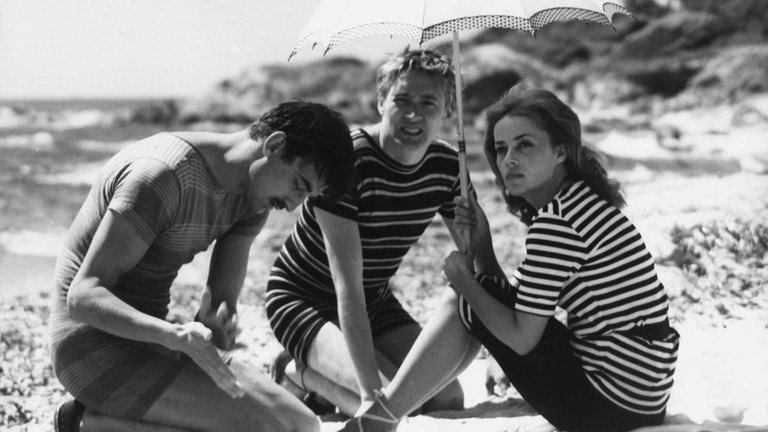Film Review: Jules and Jim (Jules et Jim, 1962)

The 1960s, a decade traditionally associated with the Sexual Revolution, also saw its expression in world cinema. Films of that time not only depicted explicit sexuality or celebrated newfound sexual freedom but also explored relationships that defied conventions and traditions. One of the more interesting examples is Jules and Jim, a 1962 period romantic drama directed by François Truffaut, best known as one of the most popular works of the French New Wave. The title itself at the time served as a synonym for practices that would now be called "polyamory."
Jules and Jim is based on Henri-Pierre Roché's semi-autobiographical novel, published in 1953. Roché, an avant-garde Dadaist artist, drew inspiration from his own experiences within a love triangle involving himself, his best friend Franz Hessel, a German writer and translator, and Hessel’s wife, Helen Grund.
The plot begins in 1912 Paris, where Jules (played by Oskar Werner), an Austrian student and aspiring writer, meets and befriends his French colleague Jim (played by Henri Serre). Despite their differences, the two men become best friends, and their friendship revolves around women, including the charming and free-spirited Catherine (played by Jeanne Moreau), whom they both pursue. She ultimately decides to marry the relatively shy Jules, fearing Jim's extroverted nature might lead to infidelity. The film follows the trio through World War I and beyond, as Jim and Jules both survive the war and later reunite in the Black Forest, where Jules now resides with Catherine and their young daughter Sabine. Jim soon realises that Catherine is unhappy and finds herself constrained by marriage, leading her to begin a romantic relationship with Jim, with Jules' apparent blessing.
Truffaut’s direction in Jules and Jim showcases his innovative approach to filmmaking that defined many early French New Wave masterpieces. He employs techniques such as jump cuts and unusual framing to create a visual style that distinguishes it from traditional cinema. These stylistic choices contribute to a fresh viewing experience for contemporary audiences while maintaining a conventional musical score by Georges Delerue that grounds the film in its emotional core. The use of narration by Michel Subor effectively conveys character backgrounds and inner thoughts without overwhelming viewers with excessive exposition or length.
However, what is particularly striking about Jules and Jim is Truffaut's challenge to societal conventions regarding monogamous relationships as the only acceptable avenue for romance and sex. The trio’s dynamic is often labelled as a "love triangle," yet it more accurately represents a ménage à trois—a relationship structure where all three characters engage in romantic entanglements while remaining within heterosexual bounds. Their exploration of love reflects the post-World War II generation's desire to break free from traditional constraints, mirroring the sentiments of the burgeoning Baby Boomer generation in the 1960s.
Despite its apparent advocacy for sexual liberation and non-traditional relationships, Jules and Jim harbours an underlying melancholy that ultimately conveys a conservative message about the nature of freedom and happiness. The film suggests that the pursuit of unrestrained liberty can be illusory; true contentment often requires reconciling one's desires with familial responsibilities. Those characters who fail to recognise this truth face tragic consequences—a theme poignantly illustrated in the film's dramatic conclusion.
While some may contest Truffaut’s perspective on love and freedom, few can dispute the remarkable talent evident in Jules and Jim. Jeanne Moreau delivers an iconic performance as Catherine, embodying complexity and charm throughout her portrayal. Her rendition of "Le Tourbillon," composed by her friend Serge Rezvani, further highlights her multifaceted character while capturing the film's playful yet tragic essence.
Nevertheless, modern viewers might find Jules and Jim somewhat dated—not solely due to its historical setting but also because of its black-and-white cinematography. Truffaut’s choice to employ monochrome visuals serves to evoke a sense of nostalgia; however, it can occasionally detract from pacing and coherence, particularly when integrated stock footage from World War I disrupts narrative flow. Additionally, some critics have noted that the film loses momentum towards its conclusion, which may leave contemporary audiences yearning for a more dynamic resolution.
Nevertheless, Jules and Jim has earned its place in cinema history and has influenced many other filmmakers, leading to various homages in later films like Willie & Phil and Threesome. Jules and Jim, despite its flaws, can be recommended not only to cinephiles but also to viewers who enjoy romantic dramas about unconventional relationships.
RATING: 7/10 (+++)
Blog in Croatian https://draxblog.com
Blog in English https://draxreview.wordpress.com/
InLeo blog https://inleo.io/@drax.leo
Hiveonboard: https://hiveonboard.com?ref=drax
InLeo: https://inleo.io/signup?referral=drax.leo
Rising Star game: https://www.risingstargame.com?referrer=drax
1Inch: https://1inch.exchange/#/r/0x83823d8CCB74F828148258BB4457642124b1328e
BTC donations: 1EWxiMiP6iiG9rger3NuUSd6HByaxQWafG
ETH donations: 0xB305F144323b99e6f8b1d66f5D7DE78B498C32A7
BCH donations: qpvxw0jax79lhmvlgcldkzpqanf03r9cjv8y6gtmk9
Posted Using InLeo Alpha
Congratulations @drax! You have completed the following achievement on the Hive blockchain And have been rewarded with New badge(s)
You can view your badges on your board and compare yourself to others in the Ranking
If you no longer want to receive notifications, reply to this comment with the word
STOPCheck out our last posts: